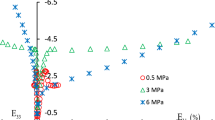Abstract
In this work, a novel numerical method is developed for simulating arbitrary crack growth in pipes with the idea of enriched shape functions which can represent the discontinuity independent of the mesh. The concept of the enriched shape functions is introduced into the continuum-based (CB) shell element. Due to the advantage of CB shell element, the shell thickness variation and surface connection can be concerned during the deformation. The stress intensity factors of the crack in the CB shell element are calculated by using the ‘equivalent domain integral’ method for 3D arbitrary non-planar crack. The maximum energy release rate is used as a propagation criterion. This method is proved able to capture arbitrary crack growth path in pipes which is independent of the element mesh. Numerical examples of different fracture patterns in pipes are presented here.
Similar content being viewed by others
References
Zhuang Z, Guo Y J. Analysis of dynamic fracture mechanism in gas pipelines. Eng Fract Mech, 1999, 64: 271–289
Nishioka T. Computational dynamic fracture mechanics. Int J Fract, 1997, 86: 127–159
Belytschko T, Black T. Elastic crack growth in finite elements with minimal remeshing. Int J Numer Methods Eng, 1999, 45: 601–620
Moes N, Dolbow J, Belytschko T. A finite element method for crack growth without remeshing. Int J Numer Methods Eng, 1999, 46: 131–150
Moes N, Belytschko T. Extended finite element method for cohesive crack growth. Eng Fract Mech, 2002, 69: 813–833
Song J H, Areias P M A, Belytschko T. A method for dynamic crack and shear band propagation with phantom nodes. Int J Numer Methods Eng, 2006, 67: 868–893
Areias P M A, Belytschko T. Two-scale shear band evolution by local partition of unity. Int J Numer Methods Eng, 2006, 66: 878–910
Chessa J, Belytschko T. An extended finite element method for two-phase fluids. J Appl Mech, 2003, 70, 1: 10–17
Ma S, Zhang X, Qiu X M. Comparison study of MPM and SPH in modeling hypervelocity impact problems. Int J Impact Eng, 2009, 36: 72–282
Areias P M A, Belytschko T. Non-linear analysis of shells with arbitrary evolving cracks using XFEM. Int J Numer Methods Eng, 2005, 62: 384–415
Song J H, Belytschko T. Dynamic fracture of shells subjected to impulsive loads. J Appl Mech, 2009, 76: 051301
Areias P M, Song J H, Belytschko T. Analysis of fracture in thin shells by overlapping paired elements. Comput Methods Appl Mech Eng, 2006, 195: 5343–5360
Wyart E, Coulon D, Duflot M, et al. A substructured FE-shell/XFE-3D method for crack analysis in thin-walled structures. Int J Numer Methods Eng, 2007, 72: 757–779
Rabczuk T, Areias PMA, Belytschko T. A meshfree thin shell method for non-linear dynamic fracture. Int J Numer Methods Eng, 2007, 72: 524–548
Gato C. Detonation-driven fracture in thin shell structures: Numerical studies. Appl Math Model, 2010, 34: 3741–3753
Ahmad S, Irons B B, Zienkiewicz O C. Analysis of thick and thin shell structures by curved finite elements. Int J Numer Methods Eng, 1970, 2: 419–451
Hughes T J R, Liu W K. Nonlinear finite element analysis of shells: Part 1, Two-dimensional shells. Comput Methods Appl Mech Eng, 1981, 26: 167–181
Hughes T J R, Liu W K. Nonlinear finite element analysis of shells: Part 2, Three-dimensional shells. Comput Methods Appl Mech Eng, 1981, 26: 331–362
Buechter N, Ramm E. Shell theory versus degeneration-a comparison of large rotation finite element analysis. Int J Numer Meth Eng, 1992, 34: 39–59
Simo J C, Fox D D. On a stress resultant geometrically exact shell model, Part I: Formulation and optimal parametrization. Comput Methods Appl Mech Eng, 1989, 72: 267–304
Parisch H. A continuum-based shell theory for non-linear applications. Int J Numer Methods Eng, 1995, 38: 1855–1883
Belytschko T, Liu W K, Moran B. Nonlinear Finite Element Method for Continua and Structures. New York: John Wiley & Sons, Ltd., 2000
Belytschko T, Moes N, Gravouil A. Non-planar 3D crack growth by the extended fnite element and level sets-Part I: Mechanical model. Int J Numer Methods Eng, 2002, 53: 2549–2568
Nikishkov G P, Atluri S N. Calculation of fracture mechanics parameters for an arbitrary three-dimensional crack, by the’ equivalent domain integral’ method. Int J Numer Methods Eng, 1987, 24: 1801–1821
Shivakumar K N. An equivalent domain integral method for three-dimensional mexed-mode fracture problems. Eng Fract Mech, 1992, 42: 935–959
Chang J, Xu J Q, Mutoh Y. A general mixed-mode brittle fracture criterion for cracked materials. Eng Fract Mech, 2006, 73: 1249–1263
Author information
Authors and Affiliations
Corresponding author
Rights and permissions
About this article
Cite this article
Zhuang, Z., Cheng, B. A novel enriched CB shell element method for simulating arbitrary crack growth in pipes. Sci. China Phys. Mech. Astron. 54, 1520–1531 (2011). https://doi.org/10.1007/s11433-011-4385-y
Received:
Accepted:
Published:
Issue Date:
DOI: https://doi.org/10.1007/s11433-011-4385-y



